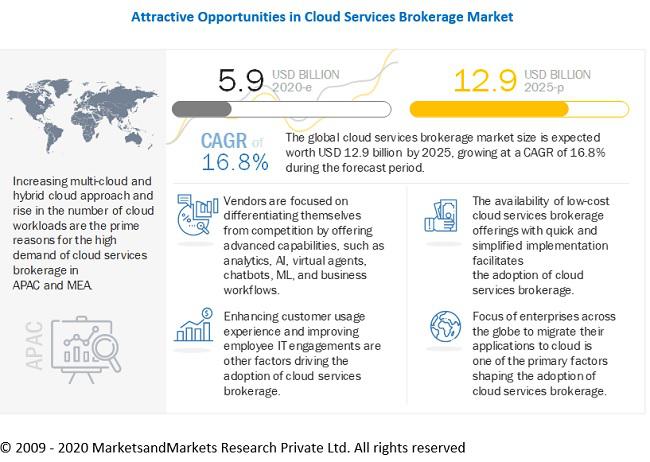DUBLIN, April 27, 2022 /PRNewswire/ -- The "Cloud Service Brokerage Market by Business Model, Platform Type, Deployment Type, Service Type and Industry Verticals 2022 - 2027" report has been added to ResearchAndMarkets.com's offering.
The overall global market is poised to reach $23.6 billion by 2027
This cloud service brokerage market report provides an assessment for the CSB market, including segment definition, advantages/disadvantages, enabling technologies, business models and assessment of the major industry players.
The report evaluates the market by platform type, deployment type and industry vertical penetration. It assesses the fundamentals of cloud service brokerage model along with its potential benefits, enabling technologies, business models, major industry players, and the future outlook of the market through 2027.
Cloud services have already caused a major transformation in technologies and a shift in business operations focus that has affected everything from ERP to data center planning. One of the crucial aspects of the next phases in the evolution of cloud services will be the extent to which various players can deal with the anticipated scope of many supplier/customer relationships and associated scale of data exchange and transactions.
The industry has evolved from in-app authorization to standard interfaces/procedures to centralized abstraction and now to Cloud Service Brokers (CSB). The fundamental CSB functions are to aggregate, simplify, secure, and integrate data, communications, and commerce between vendors. These functions are often referred to as Cloud Intermediation services and include both technical and business process mediation on a cloud-to-cloud basis.
We see AI technologies performing assigned network tasks and machine learning-based dynamic operations without interrupting user experience. Users are able to access networks via virtual applications regardless of the devices they use, enabling management of network configuration and other functions. The CSB model transforms network management functions into intelligent and responsive automation and optimization procedures.

Select Report Findings:
Key Topics Covered:
1.0 Executive Summary
2.0 Introduction
2.1 The Cloud Service Brokerage Function
2.1.1 CSB Functions
2.1.2 CSB Advantages
2.2 CSB System Architecture
2.3 Growth Drivers Analysis
2.3.1 Ease of Use
2.3.2 Finding New Services
2.3.3 Comparison Shopping
2.3.4 Cloud Bartering
2.3.5 Easy-to-Understand SLA
2.3.6 Brokerage
2.3.7 Simplified Deployment
2.3.8 Better Interface
2.3.9 Lower Cost
2.3.10 Support and Troubleshooting
2.4 Market Challenge Analysis
2.4.1 Interoperability
2.4.2 Automation
2.4.3 Marketplace
2.4.4 Commoditization
2.4.5 Federated Clouds
2.5 Cloud Brokers Role
2.5.1 Service Oriented Architecture
2.5.2 Basic Cloud Service Brokerage
2.6 Cloud Service Brokerage Workflow
2.6.1 Service Engineering Phase
2.6.2 Service Onboarding Phase
2.6.3 Service Evolution Phase
2.7 CSB Services
2.7.1 Cloud Aggregation
2.7.2 Cloud Arbitrage
2.7.3 Cloud Service Intermediation
2.8 Cloud Computing Investment
2.9 CSB Recent Development and Trend
2.9.1 Shaping Business Model
2.9.2 SaaS Brokerage for Telecom Companies
2.9.3 IaaS Brokerage for Enterprises
2.9.4 The Unified Cloud Brokerage Model
2.9.5 SaaS and IaaS Potential Interchange
3.0 Technology and Application Analysis
3.1 CSB Deployment Types
3.1.1 Internal CSBs
3.1.1.1 The Business Case for an Internal CSB role
3.1.1.1.1 The Evolution of Hybrid IT
3.1.1.1.2 Multiple Clouds, Multiple Challenges
3.1.1.1.3 SaaS Sprawl
3.1.1.1.4 IT as a Service
3.1.2 External CSBs
3.1.2.1 The Business Case for External CSB Role
3.1.2.1.1 Telecommunications Service Providers
3.1.2.1.2 IT Distributors and Service Providers
3.1.2.1.3 Technology Providers
3.2 CSB Business Models
3.2.1 Software as a Service
3.2.1.1 SaaS Show Case
3.2.1.1.1 Microsoft Office Live
3.2.1.1.2 Google Apps
3.2.2 Platform as a Service
3.2.3 Infrastructure as a Service
3.2.3.1 IaaS Show Case
3.3 Cloud Deployment Strategies
3.3.1 Public Cloud
3.3.2 Private Cloud
3.3.3 Hybrid Cloud
3.3.4 Community cloud
3.4 Enabling Technologies
3.4.1 Infrastructure Scaling
3.4.2 Virtualization
3.4.3 Virtual Machine Migration
3.4.4 Equipment Power State Adjustment
3.5 CSB Service Elements
3.5.1 Service Cataloging / Ordering / Billing
3.5.2 Data Analytics / Data-as-a-Service
3.5.3 Security / Secure SaaS
3.5.3.1 Demand for SaaS Security
3.5.3.2 Growth Drivers
3.5.3.2.1 Growing Cyber-attacks
3.5.3.2.2 Sophisticated Threats
3.5.3.2.3 Government Security Requirements
3.5.3.3 Challenges
3.5.3.3.1 Identity Management
3.5.3.3.2 Weak Cloud Security Standards
3.5.3.3.3 Secrecy
3.5.3.3.4 Risks of Cloud Access Anywhere Capability
3.5.3.4 Cloud Security Brokerage
3.5.4 Low-Cost Computing
3.5.4.1 Demand for Low Cost Computing
3.5.4.2 Challenges for Low Cost Computing
3.5.4.3 Low Cost Computing through Cloud Service Brokerage
3.5.4.4 Cloud Management
3.5.4.5 Resource Contention Management
3.5.4.6 Service Management
3.5.4.7 Mobility
4.0 Company Analysis
4.1 AppDirect
4.2 Appirio
4.3 AWS (Amazon)
4.4 BlueWolf
4.5 Capgemini SA
4.6 CloudMore
4.7 Clouditalia
4.8 Cloud Compare
4.9 Dell Inc.
4.10 Gravitant
4.11 Green Cloud Technologies
4.12 Infosys
4.13 Issal
4.14 IBM
4.15 Jamcracker
4.16 Liaison Technologies
4.17 Nephos Networks
4.18 Nephos Technologies
4.19 Nuvotera
4.20 SoftChoice Cloud
4.21 Verio
4.22 Virtacore
4.23 Accenture PLC
4.24 ActivePlatform
4.25 BMC Software Inc.
4.26 BT Wholesale
4.27 Fujitsu
4.28 HPE
4.29 Microsoft
4.30 NEC Corporation
4.31 VMware
4.32 ALSO Holding AG
4.33 Arrow Electronics
4.34 Atos SE
4.35 BitTitan
4.36 Cloud Connect Sdn. Bhd.
4.37 Apptio Inc. (Cloudability)
4.38 CloudBroker GmBH
4.39 CloudFX
4.40 CloudSME
4.41 Cognizant
4.42 Doublehorn
4.43 DXC Technology
4.44 Eshgro
4.45 Flexera
4.46 InContinuum Software
4.47 iPortalis
4.48 NTT Data
4.49 OpenText Corporation
4.50 Oracle Corporation
4.51 Pax8
4.52 Proximitum
4.53 Shivaami
4.54 Tata Consultancy Services
4.55 Tech Mahindra Limited
4.56 Wipro Limited
5.0 Market Analysis and Forecasts 2022 - 2027
5.1 Global Cloud Service Brokerage Market 2022 - 2027
5.1.1 Global Cloud Service Brokerage Market
5.1.2 Global Cloud Service Brokerage Market by Service Type
5.1.3 Global Cloud Service Brokerage Market by Business Model Type
5.1.4 Global Cloud Service Brokerage by Platform Type
5.1.5 Global Cloud Service Brokerage Market by Deployment Type
5.1.6 Global Cloud Service Brokerage Market by Enterprise Type
5.1.7 Global Cloud Service Brokerage Market by Industry Vertical
5.1.8 Global Cloud Service Brokerage Market by Region
5.2 Regional Cloud Service Brokerage Market 2022 - 2027
6.0 Conclusions and Recommendations
For more information about this report visit https://www.researchandmarkets.com/r/k924hx
Media Contact:
Research and Markets
Laura Wood, Senior Manager
press@researchandmarkets.com
For E.S.T Office Hours Call +1-917-300-0470
For U.S./CAN Toll Free Call +1-800-526-8630
For GMT Office Hours Call +353-1-416-8900
U.S. Fax: 646-607-1907
Fax (outside U.S.): +353-1-481-1716
View original content:https://www.prnewswire.com/news-releases/global-cloud-service-brokerage-market-report-2022-2027-assessment-of-advantagesdisadvantages-enabling-technologies-business-models-and-major-industry-players-301534023.html
SOURCE Research and Markets




